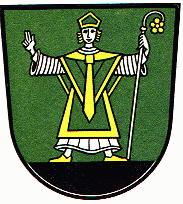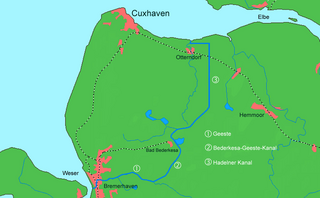
Cuxland, in a tourist sense, is the land between the River Weser and the mouth of the Elbe in the district of Cuxhaven on Germany's North Sea coast.

Cuxland, in a tourist sense, is the land between the River Weser and the mouth of the Elbe in the district of Cuxhaven on Germany's North Sea coast.
The term Cuxland is an artificial word that has purely been coined for tourist purposes and has no historic significance. It particularly refers to the resorts of the Land Wursten like Dorum, Wremen and Midlum, but also the town of Cuxhaven and resorts of Sahlenburg, Duhnen within its borough Döse, as well as the town of Otterndorf.
The central attractions of Cuxland are Sahlenburg, Duhnen und Döse, which have a well developed tourist infrastructure with restaurants and hotels to cater for various tastes, holiday apartments, an open air pool, leisure facilities and shops. Additionally you can visit a number of museums in Cuxhaven, for example a museum about the German poet Joachim Ringelnatz in the Schloss Ritzebüttel (Castle Ritzebüttel).
The majority of the holidaymakers come from the German states of Lower Saxony, North Rhine-Westphalia, Bremen and Hamburg. With around 3 million overnight stays each year, Cuxhaven is the leading resort in Germany. The coastal villages in the collective municipality of Land Wursten and in the borough of Otterndorf are especially popular with families. Inland, spa facilities, cycling and riding are popular; the centre being Bad Bederkesa.
A local holiday park company secured the rights to the word "Cuxland" since 1997 as a brand.
In summer 2008 there were disputes about this. In connection with that the county council decided in favour of the general and wide use of the term "Cuxland".

Cuxhaven is a town and seat of the Cuxhaven district, in Lower Saxony, Germany. The town includes the northernmost point of Lower Saxony. It is situated on the shore of the North Sea at the mouth of the Elbe River. Cuxhaven has a footprint of 14 kilometres (east–west) by 7 km (4 mi) (north–south). Its town quarters Duhnen, Döse and Sahlenburg are especially popular vacation spots on the North Sea and home to about 52,000 residents.

Arensch is a local part of Cuxhaven, a town in Lower Saxony, Germany.

Sahlenburg is a borough of the city Cuxhaven near the mouth of the river Elbe in Lower Saxony, Germany. The Sahlenburg beach is popular with tourists. In addition to swimming in the sea when the tide permits, there are also walks into the Duhner and the Werner forests.

Otterndorf is a town on the coast of the North Sea in the federal state of Lower Saxony, Germany, and is part of the collective municipality of Land Hadeln. The town, located in the administrative district of Cuxhaven, is at the mouth of the river Medem, part of the Elbe delta. The old town centre (Altstadt) features a number of half-timbered houses.

Mulsum is a village and a former municipality in the district of Cuxhaven, in Lower Saxony, Germany. Since 1 January 2015 it is part of the municipality Wurster Nordseeküste. It is located on Wurster Landstraße, L129, between Dorum to the north-east, and Wremen to the south-west. The town is two-and-a-half miles east of the North Sea.

Bad Bederkesa is a village and a former municipality in the district of Cuxhaven, in Lower Saxony, Germany. Since 1 January 2015 it is part of the town of Geestland. It is situated approximately 20 km northeast of Bremerhaven, and 30 km southeast of Cuxhaven. Bad Bederkesa was the seat of the former Samtgemeinde Bederkesa, an administrative division consisting of several component municipalities.

Land Wursten is a former Samtgemeinde in the district of Cuxhaven, in Lower Saxony, Germany. It was situated approximately 20 km (12 mi) southwest of Cuxhaven, and 15 km (9.3 mi) north of Bremerhaven. Its seat was in the village Dorum. It was disbanded in January 2015, when its member municipalities merged into the new municipality Wurster Nordseeküste.

Dorum is a village and a former municipality in the district of Cuxhaven, in Lower Saxony, Germany. Since 1 January 2015 it has been part of the municipality Wurster Nordseeküste.

The region between the Elbe and Weser rivers forms the Elbe–Weser triangle, also rendered Elbe-Weser Triangle, in northern Germany. It is also colloquially referred to as the Nasses Dreieck or "wet triangle".
The Middle Weser Region includes, in its fullest sense, the land along the Middle Weser between Minden and Bremen. It lies within the federal states of North Rhine-Westphalia, Lower Saxony and Bremen. However, the term is often used just to refer to the Lower Saxon part, because of the different political development of the three states and the cooperative associations formed in Lower Saxony some years ago. The Lower Saxon part of the Middle Weser Region forms the geographical heart of this state. In the centre of the Middle Weser Region are the towns of Minden, Nienburg/Weser and Verden (Aller). In the extreme north, the city of Bremen, which is not part of Lower Saxony, has a very important influence on that area of Lower Saxony surrounding it.

Land Hadeln is a historic landscape and former administrative district in Northern Germany with its seat in Otterndorf on the Lower Elbe, the lower reaches of the River Elbe, in the Elbe-Weser Triangle between the estuaries of the Elbe and Weser.

The Elbe–Weser waterway or Elbe–Weser shipping channel is a short-cut between the rivers Elbe and Weser in North Germany which is part-canal and part-river. It has a length of 54.7 kilometres (34.0 mi) and is designed for smaller coastal vessels. It includes some 60 kilometres (37 mi) of canal dykes and 45 kilometres (28 mi) of canal paths. The channel starts in Otterndorf with the Hadeln Canal, then becomes the Bederkesa-Geeste Canal from the town of Bad Bederkesa to the River Geeste, the final leg of the shipping channel, which flows into the Weser at Bremerhaven. It is owned by the state of Lower Saxony, maintained by the NLWKN from its Stade office. Today they just look after maintenance of the drainage system, because the economic element of the canal – commercial shipping which was particularly thriving in the late 1960s – declined increasingly from 1973 onwards and today hardly exists at all. Nevertheless, the waterway is still used by smaller yachts as a short cut between Elbe and Weser.

The Großer Knechtsand is a large sandbank beyond the Weser and Elbe estuaries in the eastern part of Lower Saxony's Wadden Sea off the coast of North Germany. It lies between the islands of Mellum and Neuwerk. The central area of the sandbank lies above the high water mark, forming the Hochsand of Hoher Knechtsand, which was formerly an island. The Hochsand lies 11 km west of the village of Berensch on the nearest part of the mainland in the borough of Cuxhaven in the Land Wursten.
Duhnen is a seaside resort (Seebad ) along the North Sea, 5 kilometres (3.1 mi) from the centre of Cuxhaven city, Lower Saxony, Germany. Duhnen is located 351 kilometres (218 mi) northwest of Berlin. In 1935 Duhnen was incorporated into the city of Cuxhaven, more than 100 years after the city had been established. Visitors to Hamburg's nearby island of Neuwerk commonly travel through Duhnen. It was at one time a remote fishing and farming village, but today is one of the tourist centres of Cuxland.

Döse the northernmost town in Lower Saxony, Germany at the point where the River Elbe flows into the North Sea. It is a borough of the city Cuxhaven and a popular seaside resort. Döse is located west of Grimmershörn in the borough of Cuxhaven and is one of the tourist centres of the region of Cuxland.

Wurster Nordseeküste is a municipality in the district of Cuxhaven, in Lower Saxony, Germany. It takes its name from the historic region Land Wursten and the North Sea coast. It was formed on 1 January 2015 by the merger of the former municipalities Nordholz, Cappel, Dorum, Midlum, Misselwarden, Mulsum, Padingbüttel and Wremen.

Ritzebüttel Castle in Cuxhaven was the residence of the Hamburg bailiffs, back when Ritzebüttel still belonged to the city of Hamburg. The castle, part of which dates back to the 14th century, is one of the oldest preserved secular buildings of the North German Brick Gothic style in the region and is now open to visitors.